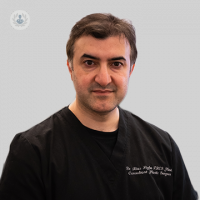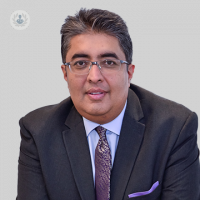What is it?
Rhinoseptoplasty is a type of plastic surgery performed to correct and reconstruct the nasal septum (bridge) for aesthetic and medical purposes. This is what makes the difference between rhinoseptoplasty and a simpler rhinoplasty (which only aims at aesthetically enhancing the nose) or a septoplasty (which only corrects and reconstructs the nose for medical purposes). This procedure yields better results when doing a mild remodelling and reconstructing.

What is it for?
From a strictly medical angle, rhinoseptoplasty is usually done to treat any problems arising from a deviated septum. Other potential issues include:
- Respiratory impediments, caused by an obstruction due to the deviated septum
- Trouble falling asleep
- Dry mouth from breathing with your mouth
- Rhinorrhoea (getting frequent nosebleeds)
From an aesthetics angle, any kind of defect can be corrected; there are several different types of aesthetics enhancements to the nose available.
How does it work?
Before the surgery, you will be given either local anaesthetics or general anaesthetics.
During the septoplasty phase, the surgeon will make an incision on your septum. If the remodelling is simple enough, the surgeon will be able to reposition the septum without needing to move it first. Otherwise, the surgeon will have to remove the septum, straighten it up and place it back within the nose. After that, the surgeon will suture the nose up.
The rhinoplasty can be either a closed procedure (by making an incision within the nose) or an open procedure (by making an incision at the base of the nose). After the surgery, an external cast will be placed on your nose, which will be removed less than a week after the procedure.
How can I prepare for it?
Before the surgery, you need to:
- Schedule a visit with the surgeon to talk about the procedure, what results you expect and to go through your medical history;
- Have an ECG, blood pressure measurement, blood test and urine test;
- If you smoke, quit smoking and stop taking anticoagulants and platelet aggregation inhibitors, to avoid any complications (such as epistaxis) during the procedure.
Post-operative progress
You will be in hospital for one day after the surgery. However, complete recovery may take several months (from three months to a whole year in some cases). It is fairly common to feel pain in your nose and have some nosebleeds in the week immediately after the surgery.
You should avoid smoking in the days after surgery. You should also avoid any strenuous physical activity, keep your head lifted up while sleeping and make sure you don’t blow your nose for some time after the procedure.
You can go back to work roughly one week after the rhinoseptoplasty. The plastic surgeon will generally recommend periodic check-ups to monitor the recovery process.
10-02-2015 04-27-2023Septorhinoplasty
Mr Riaz Agha - Plastic surgery
Created on: 10-02-2015
Updated on: 04-27-2023
Edited by: Conor Dunworth
What is it?
Rhinoseptoplasty is a type of plastic surgery performed to correct and reconstruct the nasal septum (bridge) for aesthetic and medical purposes. This is what makes the difference between rhinoseptoplasty and a simpler rhinoplasty (which only aims at aesthetically enhancing the nose) or a septoplasty (which only corrects and reconstructs the nose for medical purposes). This procedure yields better results when doing a mild remodelling and reconstructing.

What is it for?
From a strictly medical angle, rhinoseptoplasty is usually done to treat any problems arising from a deviated septum. Other potential issues include:
- Respiratory impediments, caused by an obstruction due to the deviated septum
- Trouble falling asleep
- Dry mouth from breathing with your mouth
- Rhinorrhoea (getting frequent nosebleeds)
From an aesthetics angle, any kind of defect can be corrected; there are several different types of aesthetics enhancements to the nose available.
How does it work?
Before the surgery, you will be given either local anaesthetics or general anaesthetics.
During the septoplasty phase, the surgeon will make an incision on your septum. If the remodelling is simple enough, the surgeon will be able to reposition the septum without needing to move it first. Otherwise, the surgeon will have to remove the septum, straighten it up and place it back within the nose. After that, the surgeon will suture the nose up.
The rhinoplasty can be either a closed procedure (by making an incision within the nose) or an open procedure (by making an incision at the base of the nose). After the surgery, an external cast will be placed on your nose, which will be removed less than a week after the procedure.
How can I prepare for it?
Before the surgery, you need to:
- Schedule a visit with the surgeon to talk about the procedure, what results you expect and to go through your medical history;
- Have an ECG, blood pressure measurement, blood test and urine test;
- If you smoke, quit smoking and stop taking anticoagulants and platelet aggregation inhibitors, to avoid any complications (such as epistaxis) during the procedure.
Post-operative progress
You will be in hospital for one day after the surgery. However, complete recovery may take several months (from three months to a whole year in some cases). It is fairly common to feel pain in your nose and have some nosebleeds in the week immediately after the surgery.
You should avoid smoking in the days after surgery. You should also avoid any strenuous physical activity, keep your head lifted up while sleeping and make sure you don’t blow your nose for some time after the procedure.
You can go back to work roughly one week after the rhinoseptoplasty. The plastic surgeon will generally recommend periodic check-ups to monitor the recovery process.


Rhinoplasty: what are the risks and what happens if I’m not satisfied with my new nose?
By Professor Charles Malata
2024-12-15
As with any cosmetic procedure, the results of a nose job are not always guaranteed. While complications are quite rare, they can still occur and it is important to be fully aware of them before choosing to undergo this procedure. In addition, a small proportion of people aren't always happy with how their nose looks after, so you should understand the steps you need to follow in case this happens to you. One of our top plastic surgeons, Professor Charles Malata explains more. See more


What is a septorhinoplasty?
By Mr Florian Bast
2024-12-15
A septorhinoplasty is a combination of rhinoplasty and septoplasty surgery to improve the function and aesthetic of the nose. Expert otolaryngologist Mr Florian Bast explains what happens during the operation and what steps to take for recovery in the early weeks following the procedure. See more


Functional rhinoplasty: what is it, who needs it and recovery
By Mr Gaurav Kumar
2024-12-14
Expert otolaryngologist Mr Gaurav Kumar describes functional rhinoplasty, A procedure chosen by many in order to improve breathing and smelling, in addition to the well known aesthetic benefits. See more


Complications, dos and don’ts of septorhinoplasty
By Mr Joe Marais
2024-12-14
Septorhinoplasty is a surgical procedure that aims to reconstruct and correct the nasal septum, both for medical or aesthetic purposes. As with any surgical procedure, there are potential complications to be aware of, as well as an important list of 'dos and don'ts' to follow post-surgery. Mr Joe Marais, a leading plastic and ENT surgeon, summarises these for us. See more
Experts in Septorhinoplasty
-
Professor Hesham Saleh
Otolaryngology / ENTExpert in:
- Rhinoplasty (nose job)
- Septorhinoplasty
- Endoscopic sinus surgery
- Septoplasty
- Sinusitis
- CSF Leak
-
Mr Nicholas Eynon-Lewis
Otolaryngology / ENTExpert in:
- Vertigo
- Voice disorders
- Tinnitus
- Sinusitis
- Septorhinoplasty
- Blocked nose
-
Mr Santdeep Paun
Otolaryngology / ENTExpert in:
- Rhinoplasty (nose job)
- Septorhinoplasty
- Facelift
- Earfold®
- Nasal trauma
- Otoplasty
-
Professor Paul Chatrath
Otolaryngology / ENTExpert in:
- Septoplasty
- Tonsillitis
- Pinnaplasty
- Rhinitis
- Sinusitis
- Septorhinoplasty
-
Professor Peter Andrews
Otolaryngology / ENTExpert in:
- Rhinoplasty (nose job)
- Septorhinoplasty
- Endoscopic sinus surgery
- Nasal septal perforation
- Endoscopic skull base surgery
- Sinusitis
- See all

London Bridge Hospital - part of HCA Healthcare
London Bridge Hospital - part of HCA Healthcare
27 Tooley St
No existe teléfono en el centro.
By using the telephone number provided by TOP DOCTORS, you automatically agree to let us use your phone number for statistical and commercial purposes. For further information, read our Privacy Policy
Top Doctors

The London Independent Hospital - part of Circle Health Group
The London Independent Hospital - part of Circle Health Group
1 Beaumont Square, Stepney Green
No existe teléfono en el centro.
By using the telephone number provided by TOP DOCTORS, you automatically agree to let us use your phone number for statistical and commercial purposes. For further information, read our Privacy Policy
Top Doctors

The ENT Consultancy
The ENT Consultancy
23 Craven Rd, Reading
No existe teléfono en el centro.
By using the telephone number provided by TOP DOCTORS, you automatically agree to let us use your phone number for statistical and commercial purposes. For further information, read our Privacy Policy
Top Doctors
-
London Bridge Hospital - part of HCA Healthcare
27 Tooley St, Central LondonExpert in:
- 24-hour service
- Cardiology
- Minimal access surgery (keyhole surgery)
- Orthopaedic surgery
- Cardiovascular disease
- Gastroenterology
-
The London Independent Hospital - part of Circle Health Group
1 Beaumont Square, Stepney Green, East LondonExpert in:
- Cataracts
- Bariatric Surgery
- Maxillofacial Surgery
- Neurological spinal surgery
- Orthopaedic surgery
- Orthopaedic spinal surgery
-
The ENT Consultancy
23 Craven Rd, Reading , ReadingExpert in:
- Voice disorders
- Ear infection
- Hearing loss
- Adult and paediatric services
- Most viewed diseases, medical tests, and treatments
- Nystagmus
- Facial feminisation surgery
- Migraine
- Minimal access surgery (keyhole surgery)
- Head and neck cancer
- Neck lump
- Acellular dermal matrix (ADM)
- Prepectoral breast reconstruction
- One Stop Breast Clinic
- Botulinum toxin (Botox™)








